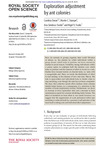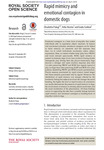Search
Now showing items 1-10 of 11
Familiar and unfamiliar face recognition in crested macaques
(The Royal Society, 2015)
Many species use facial features to identify conspecifics, which is necessary to navigate a complex social environment. The fundamental mechanisms underlying face processing are starting to be well understood in a variety ...
Social dominance modulates eavesdropping in zebrafish
(The Royal Society, 2015)
Group living animals may eavesdrop on signalling interactions between conspecifics and integrate it with their own past social experience in order to optimize the use of relevant information from others. However, little ...
Exploration adjustment by ant colonies
(2016)
How do animals in groups organize their work? Division of labour, i.e. the process by which individuals within a group choose which tasks to perform, has been extensively studied in social insects. Variability among ...
Social familiarity affects Dianamonkey alarm call responses in habitat-specific ways
(2016)
Male Diana monkeys produce loud and acoustically distinct alarm calls to leopards and eagles that propagate over long distances, much beyond the immediate group. Calling is often contagious, with neighbouring males responding ...
Multiple behavioural morphological and cognitive developmental changes arise froma single alteration
(2016)
Subtle variations in early rearing environment influence morphological, cognitive and behavioural processes that together impact on adult fitness. We manipulated habitat complexity experienced by young pheasants (Phasianus ...
To boldly climb: behavioural and cognitive differences in migrating European glass eels
(2016)
European eel (Anguilla anguilla) is a catadromous fish species that received substantial attention as its population has markedly declined in the last three decades. The possible causes of this decline include habitat ...
Rapid mimicry and emotional contagion in domestic dogs
(2015)
Emotional contagion is a basic form of empathy that makes individuals able to experience others’ emotions. In human and non-human primates, emotional contagion can be linked to facial mimicry, an automatic and fast response ...
How far will a behaviourally flexible invasive bird go to innovate?
(2016)
Behavioural flexibility is considered a key factor in the ability to adapt to changing environments. A traditional way of characterizing behavioural flexibility is to determine whether individuals invent solutions to novel ...
Exploration adjustment Ants determine their next move at rest
(2016)
To find useful work to do for their colony, individual eusocial animals have to move, somehow staying attentive to relevant social information. Recent research on individual Temnothorax albipennis ants moving inside their ...
Estimation of self motion duration and distance in rodents
(2016)
Spatial orientation and navigation rely on information about landmarks and self-motion cues gained from multi-sensory sources. In this study, we focused on self-motion and examined the capability of rodents to extract and ...










